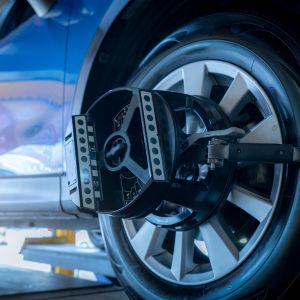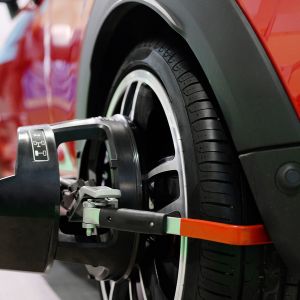A front-end alignment, also known as a two-wheeled alignment, is performed entirely on the vehicle’s front two wheels in order to correct angles. On the other hand, a four-wheel alignment, also referred to as a “full alignment,” modifies the angles of a vehicle’s four wheels. A front-end alignment can be used to modify the camber, toe, and caster angles of the front wheels and is a cost-effective fix for vehicles that only have issues with the front wheels.
However, any issues with the back wheels won’t be fixed. A four-wheel alignment, on the other hand, is a thorough repair that can increase handling and stability while extending the life of a vehicle’s tires. Problems involving all four wheels can be resolved by it. Though it may take more time and money than a front-end alignment,
The advantages and disadvantages of a front-end alignment or two-wheeled alignment

The term “a front-end alignment,” also referred to as a “two-wheel alignment,” refers to a particular kind of wheel alignment that only modifies the angles of a vehicle’s front wheels. This kind of alignment has a number of advantages and disadvantages.
Benefits:
- Cost-effective: Many car owners find front-end alignments to be more affordable than four-wheel alignments because they are typically less expensive.
- Faster: The car owner will spend less time waiting in the shop because a front-end alignment typically takes less time than a four-wheel alignment.
- Appropriate for Front-Wheel Drive Vehicles: Front-end alignment is better suited for front-wheel drive vehicles as it helps correct problems like uneven tire wear, steering wheel vibration, and pushing to one side.
Losses:
- Only the front wheels can be fixed by a front-end alignment, so the rear wheels cannot be fixed simultaneously with the front wheels.
- Rear wheel problems: Even when the front wheels are properly positioned, problems with the front wheels can be caused by improperly aligned rear wheels.
- For all-wheel or four-wheel drive vehicles, front-end alignments are inappropriate because these vehicles require a full four-wheel alignment, which is inappropriate for these vehicles.
The advantages and disadvantages of a full alignment or four-wheeled alignment

A “four-wheel alignment” is a kind of wheel alignment that modifies the angles of all four wheels on a vehicle. It is frequently referred to as a “full alignment.” With regard to this alignment technique, there are both benefits and drawbacks.
Advantages:
- Complete correction: Since a four-wheel alignment can address problems with all four wheels, any problems with the alignment of the rear wheels will also be addressed during the alignment procedure.
- Improved control and stability: By making sure that all four wheels are pointed in the right directions, a four-wheel alignment can enhance the control and stability of a vehicle.
- Suitable for all-wheel or four-wheel drive vehicles: Vehicles with all-wheel or four-wheel drive need to have a complete four-wheel alignment to make sure that all four wheels are in the right position. These vehicles are capable of four-wheel alignments.
- Increased tire life: By reducing uneven wear and tear, proper wheel alignment can contribute to an increase in tire life.
Disadvantages:
- Cost: Some car owners might be concerned about the possibility that a four-wheel alignment will be more expensive than a front-end alignment.
- Time-consuming: Since a four-wheel alignment typically takes longer to complete than a front-end alignment, the car’s owner will have to wait longer.
What is the difference between a two-wheeled and four-wheeled alignment?

Wheel alignment, for instance, involves adjusting the angles of the wheels to make sure they are perpendicular to the ground and parallel to one another. Four-wheel alignments and front-end alignments are two more. There is, however, one significant distinction between the two:
An alignment of the front end, also known as a two-wheel alignment, adjusts the angles of the car’s single front wheel. Usually done on front-wheel-drive vehicles, this alignment is meant to correct problems like uneven tire wear, steering wheel vibration, or a vehicle pulling to one side. As part of the front-end alignment process, the camber, caster, and toe angles of the front wheels are routinely checked and adjusted.
On the other hand, a four-wheel alignment, also known as a “full alignment,” modifies the angles of all four wheels on a vehicle. In order to address problems like uneven tire wear, steering wheel vibration, or a vehicle pulling to one side, this kind of alignment is frequently carried out on vehicles with all-wheel or four-wheel drive. The four-wheel alignment procedure requires measuring and adjusting the thrust, camber, caster, and toe angles of each of the four wheels.
Frequently Asked Questions
Q1. What is the purpose of front end alignment?
Ans: The front-end alignment, commonly referred to as a two-wheel alignment, modifies the angles of a vehicle’s front wheels. During a front-end alignment, the camber, toe, and caster angles are frequently modified. To ensure that the front wheels are pointed in the appropriate direction, which can improve a vehicle’s handling, stability, and tire wear, a front-end alignment is performed.
Q2. What does front-end alignment do?
Ans: A front-end alignment, commonly referred to as a two-wheel alignment, modifies the angles of a vehicle’s front wheels. The angles that are frequently altered during a front-end alignment are the camber, toe, and caster angles. In order to improve a vehicle’s handling, stability, and tire wear, a front-end alignment aims to ensure that the front wheels are pointed in the appropriate direction.
Q3. What is the average duration of a front-end alignment?
Ans: The front-end alignment’s lifespan might vary depending on the type of vehicle, the state of the roads it is driven on, and the owner’s driving habits. However, the average front-end alignment lasts between 6,000 and 12,000 miles, or 6 and 12 months. In order to keep your vehicle in good shape, you should check the alignment frequently.

